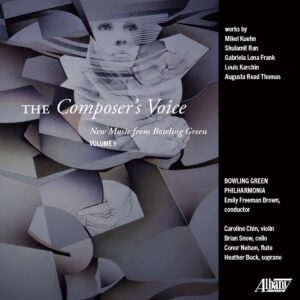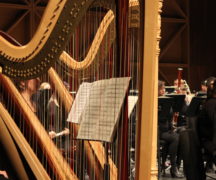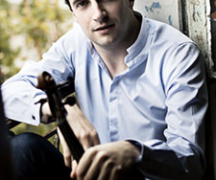By DAVID DUPONT
BG Independent News
This fall, the Bowling Green Philharmonia issued the ninth volume of its “The Composer’s Voice” series on Albany Records.
The series grew out of the annual New Music Festival at BGSU. The Sunday after the concluding concert, the orchestra assembles to record select pieces from the previous night’s performance. Every couple of years these are compiled for an album.
[RELATED: BG Philharmonia’s mastery of new sounds shines through on Volume 8 of the Composer’s Voice series]

The distinctive feature of the series is that each piece is prefaced by comments from the composer, most of the time, but occasionally the featured soloist. These spoken segments provide insight to the listener into the music, particularly what inspired its creation. The listener can then hear how this plays out in sound.
Composer Mikel Kuehn, formerly of the BGSU faculty and now teaching at Eastman School of Music, explains that his piece “Sfumato” evokes the Renaissance painting technique used to transition from one color to another, and in doing so accentuates stronger outlines. The composition came about after a 2019 visit to Florence, Italy, where he viewed a number of paintings by Leonardo Da Vinci. In “Sfumato” Kuehn draws on all the colors of the orchestra to create a dramatic musical painting.
Shulamit Ran’s “Yearning for Solo Violin & Strings with Cello Obbligato” began with a discussion about honoring the legendary musician Yehudin Menuhin. The theme was to celebrate the violinist through the qualities he embodied – love, beauty of spirit, and humaneness. Ran struggled with how to embody those abstract qualities in sound.
It was only when working on her opera “Between Two Worlds (The Dybbuk)” that she understood that the piece should be about the yearning for such qualities. That comes through in the interwoven lines of the soloists, the married duo of violinist Caroline Chin and cellist Brian Snow, both on the BGSU music faculty, as they soar through and above the orchestra.
Gabriela Frank’s “Illapa: Tone Poem for Flute and Orchestra” features another former BGSU faculty member, flutist Conor Nelson, now at the University of Wisconsin-Madison. Nelson introduces the programmatic piece. Making extensive use of the orchestra’s percussion section, Frank depicts the Incan storm god Illapa wreaking havoc over an Andean landscape. The orchestra with Nelson’s flute dancing about rises to depict the ferocity of the storm.
Composer Louis Karchin draws on the poetry of Nobel Prize-winning Irish poet Seamus Heaney for inspiration. “Four Songs on Poems of Seamus Heaney” sets the texts of four descriptive poems about a Roman theater, the music of a rain stick, a winter thunderstorm, and a harbor. Karchin searches for poems where music emerges as he reads. He went through several collections of Heaney verse to select these four. Soprano Heather Buck does the honors of giving voice to Frank’s settings.
The album concludes with Augusta Read Thomas’s “Galaxy Dances, a tone poem.”
Thomas was the gest composer at the New Music Festival both in 2020, when the event was virtual and then in 2021 when it returned in person.
[RELATED: Composer Augusta Read Thomas: ‘It’s important that artists are supported and able to do their work’]
Thomas draws inspiration from the act of creating music. “Music for me is an embrace of the world.”
Though she meticulously notates her scores, she wants them to sound like they are being improvised in the moment – she was a teenage jazz trumpet player. “Galaxy Dances” starts in the orchestra’s lowest register, dark, foreboding before springing into an exploration of its own unfolding.
The Composer’s Voice series itself documents how the music of our time is taking shape. This is very much music for now, and thanks to these recordings for future listeners to enjoy.





